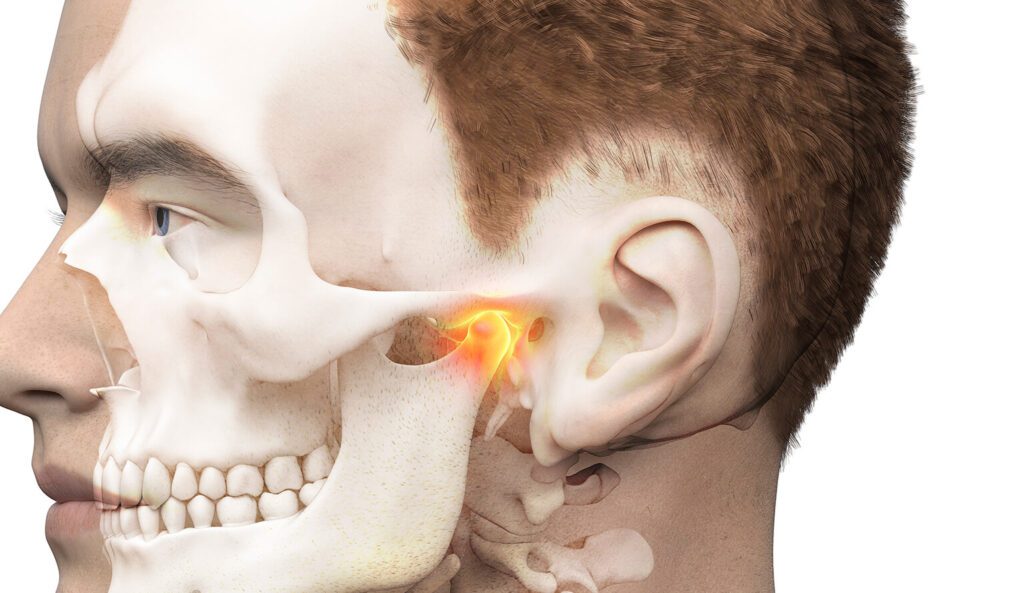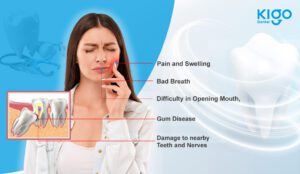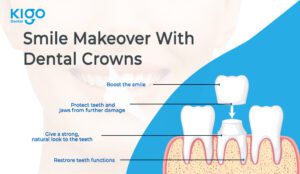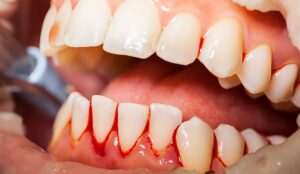TMJ Disorders (TMD)
Uncompromised quality
We use quintessential quality materials and stringent sterilisation protocols to ensure that you don't have any medical or dental complications in future.
Anxiety Free Dentistry
Experience the treatment process in a pleasant atmosphere from handpicked expert clinicians, with unparalleled clinical etiquette, to ensure exemplary health care.
Best in class outcomes
We strive our best, so that we can keep our promise of delivering the individualized smiles that we have reimagined for you with latest techniques and technologies.
TMJ Disorders: Comprehensive Treatment and Care


Do you hear popping from your jaw joints? Is there a dull ache or a sharp pain near and around the ear, spreading through scalp or cheeks? Correct diagnosis and treatment can be challenging due to the wide variety of possible causes of jaw pain. For those in need of relief, the jaw pain treatment in Hyderabad at Kigo Dental is highly effective.
The temporomandibular joint (TMJ) is a complex joint that connects the jawbone to the skull and allows for a wide range of movements, including talking, eating, and yawning. However, when this joint is damaged or experiences abnormal wear and tear, it can lead to a range of conditions collectively known as TMJ disorders or TMD.
At Kigo Dental, we understand the debilitating effects that TMJ disorders can have on a person’s quality of life. That’s why we offer comprehensive treatment and care for patients suffering from these conditions. Our team of experienced dental professionals uses the latest technologies and techniques to diagnose and treat TMJ disorders and help patients regain their oral health and function.
It can be a combination of multiple reasons why an individual suffers from TMJ problem. Disorders of the temporomandibular joint (TMJ) can be brought on by:
- Wear and tear of the inside of the TMJ / Jaw joint and surrounding structures.
- Infections, including those that cause referred pain in the jaw (such as TMJ infections and ear infections).
- Sleep-related tooth grinding or clenching that puts heavy strain on your joints.
- Incorrect bite or malocculusion.
- Injury to the head, neck, jaw, or temporomandibular joint, such as from a fall or a car accident etc.
- Tension in the jaw and teeth as a result of persistent stress.
- Genetics and environmental factors.
- Autoimmune disorders.
- Joint arthritis.
In its natural, pain-free state, a TMJ doesn’t make any noise and doesn’t restrict your range of motion or create any discomfort. You shouldn’t feel any pain or have any strange sensations while you’re chewing, eating, singing, gulping, talking, or even breathing.
The jaw muscles should be in sync, enabling you to open and close your mouth with minimal noise and maximum ease.
Something is wrong if you hear a steady stream of cracking, popping, and snapping as you go about your day. Jaw joint instability can manifest as clicking, popping, and pain. Internally, it feels like a battle between your muscles and teeth.
Tension in the jaw system develops when the teeth bite in one location while the muscles want the jaw to sit in some other spot for balance and comfort. It’s a battle between the toughness of the bite and the comfort of the jaw’s muscles and joints.
There are 3 possible outcomes of this battle
- If your muscles are winning, they’ll send a message to your brain to shift where you clench and grind your teeth to a more comfortable location. This can cause teeth to wear out quickly.
- When the teeth win the battle and signal the muscles to keep clenching to maintain support. Muscle strain and tension, along with potential increases in headache and TMJ symptoms, are the results. As a plus, you won’t experience any tooth wear.
- There are no winners in war; instead, you should expect to suffer from a combination of tooth wear and jaw pain.
Many people have pain in the face due to headaches or injuries. However, infections, jaw and tooth issues, and nerve diseases can all contribute to facial pain.
Some facial pain is localised to one area of the face, while other times the pain is felt all over the head. When diagnosing face pain, doctors may use different classification systems, including:
- Dental pain
- Vascular pain, which is caused by issues with blood vessels and blood flow.
- Neuralgia, or nerve pain, is commonly associated with issues affecting the facial nerves.
- Temporomandibular pain, which is related to the temporomandibular joint (TMJ) and the muscles of the jaw
Migraines and chronic headaches are a common problem. Many are not aware that a poor bite, or malocclusion, can lead to TMJ headaches and migraines.
In other words, headaches, migraines, forehead pain, and other symptoms that may be labelled a headache might result from a misalignment of the teeth and the resulting strain on the muscles and the brain.
There is a wide variety of triggers and treatments for headaches. When treating chronic pain, medical professionals frequently turn to medications. The use of Botox and other injectable muscle relaxants will be among these.
These treatments aim to merely “manage” pain rather than eliminate it. The same holds true for management by chiropractors, massage therapists, and other professionals. Pain is temporarily relieved with medicine and efforts are directed at relaxing the muscles of the head and neck. Although the first priority in case of chronic pain is to relieve pain, but the root cause has to be eliminated for the pain to stop permanently.
Medical treatment for headaches and migraines is possible, but orthodontic dental care is also needed for the pain to go away permanently. An orthodontist can do TMJ therapy and treatments to completely alleviate the pain.
Children aren’t the only ones who can get earaches; adults can get them too. Pain in the ears might affect either ear individually, or both ears at once. Sometimes it’s a dull ache, and other times it’s excruciatingly severe. Fevers, infections, and temporary or permanent hearing loss are all possible side effects of an earache.
Here are 8 potential causes of your ear pain:
- Bone breaks, Three tiny inner ear bones are connected to transport vibrations that contribute to sound. Not only does breaking one of these bones cause pain or deafness, but it also throws off the sequence and transmission of sound.
- Ear barotrauma is ear pain brought on by pressure changes.
- Tear in the eardrum (perforated eardrum)
- Foreign Objects
- Ear Infection
- Mastoiditis, middle ear infection
- Swimmer’s ear, or Otitis Externa
- Disorder of the temporomandibular joint (TMJ)
If TMJ issues start to damage the nerves in the ear, they can cause hearing loss, hearing loss, tinnitus, and severe ear pain.
There are treatments available today if the discomfort you’re feeling gets worse when you speak, swallow, or eat. You have probably tried using moist heat or over the counter medications to treat your muscle pain. To relax the muscles, your specialised dentist can also use Laser and electric stimulation etc.
A precisely crafted dental orthotic splint can be created by your orthodontist to help correct a misaligned bite and reduce the stress brought on by teeth grinding and clenching. Your TMJ pain and earaches could get better together with specific relaxation techniques.
Although self-diagnosis is impossible, but there are several telltale signs you can keep an eye out for. The best course of action if any of these symptoms persists is to schedule an appointment with your orthodontist for a proper diagnosis and course of action.
For convenience to identify the telltale signs, you can use our TMJ Disorders self assessment tool.
TMJ disorders can cause a range of symptoms, including:
- Unexplained pain or tenderness in the ear, jaw or face
- Difficulty opening and closing the mouth
- Clicking or popping sounds when opening and closing the mouth
- Locked jaw or limited jaw mobility
- Chronic headaches or migraines
- Tinnitus (ringing in the ears)
- Neck, shoulder, and back pain
To diagnose TMJ disorder, an orthodontist may assess various health conditions and conduct a physical examination. During the examination, the following steps may be taken:
- Examining jaw range of motion: The orthodontist will observe the movement of your jaw when you open and close your mouth.
- Feeling jaw movement: The orthodontist will assess the movement of your jaw by pressing on the surrounding area.
- Identifying discomfort site: The orthodontist will determine the location of any discomfort by pressing the surrounding area of your jaw.
- Asking questions: The orthodontist will ask questions about your teeth and jaw conditions to gain a better understanding of the problem.
If your orthodontist suspects a TMJ disorder, depending on the severity of your condition you may be required to undergo few of the additional tests, such as:
X-ray: An X-ray can help examine your teeth and jaw.
T-scan: A T-scan precisely evaluates not only the force, location, and time of a bite, but also the occlusion of the teeth.
CBCT Scan: A 3D X-ray that provides a clear picture of your teeth, jaw joints, and spine to diagnose your TMJ.
Electromyography (EMG): An EMG test identifies the activity of the muscles in your head and neck.
Joint Vibration Analysis: This test, also known as sonography, listens to the joints and provides insight into what is happening to the jaw joints.
K7 Jaw Tracking: This test tracks the path of your jaw as it moves, helping to identify the best muscle positioning.
By undergoing various combinations of these tests as decided by the specialist, a dentist or doctor can accurately diagnose TMJ disorder and recommend the most effective solutions to manage the condition.
Treatment of TMJ Disorders
Doing these could reduce flare-ups to an extent.
- Eat soft foods
- Steer clear of chewy foods
- Put a cold or hot compress on the joint that is directly below the ear.
- Reduce the stress that may be causing your jaw to clench or grind, as well as any muscle strain. You can relax by doing things like breathing exercises or meditation.
- Use the Orthodontic splint provided by orthodontist as advised. Your orthodontist will fit you with them to stop teeth grinding at night and to keep your jaw in its proper position.
- Stop smoking.
Depending on the cause of pain, the orthodontist will take call on whether to proceed with medications or other modalities, Medications are prescribed to relieve symptoms but further combination of multiple treatments are needed to manage the problem.
In some people heat therapy assists in reducing muscle tension and spasms. However, immediately after an injury to the TMJ, treatment with cold application is best.
Laser bio-stimulation sometimes helps in decreasing pain, increasing the range of motion and strength of joint.
A custom made orthodontic splint which fits over teeth is used by orthodontist to correct the abnormality in joint, followed by the splint therapy correction of bite abnormalities is achieved.
You might be suggested to a physical therapist with expertise in TMD. You’ll be given exercises to help strengthen specific muscles and increase the range of motion in your TMJ.
Your doctor may use injections to lessen pain and inflammation if the other therapies are unsuccessful.
To stop clenching and spasms, Botox injections stop muscles from contracting. It also promotes healing and prevents crushing of the teeth.
Surgery is not usually necessary for TMD patients. Surgery is typically only advised when a joint is misaligned, whether as a result of an injury or because it was always that way.
At Kigo Dental, we offer custom-fit oral appliances to treat TMJ and relieve bruxism. These appliances protect teeth, surrounding musculature and joints from excessive pressure. If oral appliances are not effective, surgical options are considered.
- Avoid teeth grinding or clenching.
- Try massages, exercise, and meditation.
- Maintain a healthy jaw and mouth position.
- Eat foods that are soft and watery, like soup or rice.
- Don’t chew gum, or bite your nails, or eat anything too crunchy.
- Sleeping on your back or side is fine. Avoid sleeping on your stomach.
- Yawn with your chin supported by your fist to lessen the strain on your jaw.
- Always try to distribute your weight evenly over both shoulders instead of relying too heavily on one.
- Regular checkups with the orthodontist.
- Drink coffee in moderation.
All of us here at Kigo Dental are committed to providing you with the best dental care available, and we do so with a smile.
Our entire staff, from receptionists to dental hygienists and assistants, is committed to providing you with the best quality dental care possible.
From the time you walk through the door and every time you revisit, you will experience this firsthand.
Kigo Dental has a team of experienced and skilled Orthodontists and other specialized dentists who specialize in providing high-quality dental care and treatments, utilizing the latest technologies and techniques to ensure the best outcomes for their patients.
FAQ's
TMD is a condition also known as TMJ Disorders, referring to a set of disorders affecting the temporomandibular joint (TMJ) and the muscles and ligaments surrounding the joint, which causes several symptoms that are unbearable.
Usually, it is a combination of several factors that causes TMD, most common factors that contribute to TMJ disorders or TMD include jaw injury, arthritis, stress, teeth grinding or clenching, and incorrect bite etc.
The most common symptoms of TMD are jaw pain, difficulty opening or closing the mouth, clicking or popping sounds in the jaw joint, headaches, and unexplained earaches, pressure behind ears etc.
TMD can be diagnosed by a specialist dentist or specialist healthcare provider who will perform a physical examination, take a medical history, and may order imaging tests, such as x-rays or a CBCT, to assess the condition of the jaw joint.
TMD treatments consist of lifestyle changes such as stress management and jaw exercises, medication, oral orthodontic appliances, physical therapy, or surgery, depending on the severity of the symptoms and the underlying cause of the disorder
While the exact cause of TMD is often a combination of several factors, taking steps to reduce stress, avoiding habits that place excessive stress on the jaw, such as teeth grinding or clenching and maintaining good body posture by getting checked for tongue ties etc. by a specialist dentist can help prevent TMD
TMD can be a chronic condition, with symptoms that come and go over time. However, with proper treatment and management, many people with TMD can manage their symptoms effectively.
Permanent curing of TMD is something for which there is a lot of research happening for a long period, but a TMJ specialist or an orthodontist can manage the symptoms of those affected very effectively, with treatment and lifestyle changes to such a level that the quality of life the person improves to the highest level possible.
TMD is a relatively common condition, affecting an estimated 35 -55% of the population. Of which one-third are aware of the problem and the rest are unaware of the problem due to which they are having those respective symptoms.
TMD can impact overall health by causing chronic pain, sleep disturbances, depression and anxiety, among other potential complications. Seeking treatment for TMD is vital to manage symptoms and prevent further complications.
The effectiveness of TMD treatment depends on the individual case and the severity of the symptoms. However, many people with TMD can manage their symptoms effectively with treatment and lifestyle changes with the help of a TMJ specialist or an orthodontist.
The length of TMD treatment can vary depending on the severity of the symptoms and the type of treatment being used. Some people may see improvement in their symptoms within a few weeks of starting treatment, while others may require longer-term treatment
While some people may be able to manage their TMD symptoms with self- care measures or over-the-counter medication, many people with TMD benefit from seeing a specialist, such as a TMJ specialist or an orthodontist, for treatment.
Lifestyle changes that may help manage TMD symptoms include stress management, avoiding habits that place excessive pressure on the jaw, such as teeth grinding or clenching, and maintaining good posture.
Medications that may be used to treat TMD are decided by specialist depending on the specific needs you have and the specific causes of your problem.
An oral Orthodontic appliance, such as an orthodontic splint, is a device that is worn in the mouth to help relieve TMD symptoms by reducing pressure on the jaw joint and/or preventing teeth from grinding or clenching.
Surgery for TMD is typically only recommended when other treatments have failed to relieve symptoms, and the condition is significantly impacting the individual’s quality of life.
While many people with TMD can manage their symptoms effectively with treatment and lifestyle changes, symptoms may return if the the underlying cause of the disorder is not addressed or if treatment is discontinued prematurely.
Blogs






Wisdom Teeth: Understanding the What, Why, and When
Wisdom teeth, also known as third molars, are often a source of concern for many people. They can lead to various dental issues, including wisdom






Smile Makeover with Dental Crowns: Types, Overview & cost
A smile is one of the most attractive features a person can have. It can boost your confidence, make you more approachable, and even improve






Beyond the smile: Exploring the crucial role of teeth in your overall health
Teeth are often linked to the ability to smile, eat, and express oneself. However, teeth serve many other vital purposes as well. Your teeth have






The Silent Threat: How Gum Diseases Lead to Tooth Loss
Having strong teeth and gums is a reflection of your entire well-being, not simply your appearance. Despite this, many people don’t give their gums the






The Importance of Orthodontists in Clear Aligner Treatment: Avoiding Problems and Ensuring Successful Outcomes
More and more individuals are seeking out clear aligner treatment as a way to improve their smile in a way that is both subtle and






Understanding Abnormal Dental Habits in Children and the Importance of Control
As parents and caregivers, we play a pivotal role in shaping our children’s habits and behaviors, especially when it comes to their oral health. However,






Wisdom Teeth: Understanding the What, Why, and When
Wisdom teeth, also known as third molars, are often a source of concern for many people. They can lead to various dental issues, including wisdom






Smile Makeover with Dental Crowns: Types, Overview & cost
A smile is one of the most attractive features a person can have. It can boost your confidence, make you more approachable, and even improve






Beyond the smile: Exploring the crucial role of teeth in your overall health
Teeth are often linked to the ability to smile, eat, and express oneself. However, teeth serve many other vital purposes as well. Your teeth have






The Silent Threat: How Gum Diseases Lead to Tooth Loss
Having strong teeth and gums is a reflection of your entire well-being, not simply your appearance. Despite this, many people don’t give their gums the






The Importance of Orthodontists in Clear Aligner Treatment: Avoiding Problems and Ensuring Successful Outcomes
More and more individuals are seeking out clear aligner treatment as a way to improve their smile in a way that is both subtle and






Understanding Abnormal Dental Habits in Children and the Importance of Control
As parents and caregivers, we play a pivotal role in shaping our children’s habits and behaviors, especially when it comes to their oral health. However,






Wisdom Teeth: Understanding the What, Why, and When
Wisdom teeth, also known as third molars, are often a source of concern for many people. They can lead to various dental issues, including wisdom






Smile Makeover with Dental Crowns: Types, Overview & cost
A smile is one of the most attractive features a person can have. It can boost your confidence, make you more approachable, and even improve






Beyond the smile: Exploring the crucial role of teeth in your overall health
Teeth are often linked to the ability to smile, eat, and express oneself. However, teeth serve many other vital purposes as well. Your teeth have






The Silent Threat: How Gum Diseases Lead to Tooth Loss
Having strong teeth and gums is a reflection of your entire well-being, not simply your appearance. Despite this, many people don’t give their gums the






The Importance of Orthodontists in Clear Aligner Treatment: Avoiding Problems and Ensuring Successful Outcomes
More and more individuals are seeking out clear aligner treatment as a way to improve their smile in a way that is both subtle and






Understanding Abnormal Dental Habits in Children and the Importance of Control
As parents and caregivers, we play a pivotal role in shaping our children’s habits and behaviors, especially when it comes to their oral health. However,






Wisdom Teeth: Understanding the What, Why, and When
Wisdom teeth, also known as third molars, are often a source of concern for many people. They can lead to various dental issues, including wisdom






Smile Makeover with Dental Crowns: Types, Overview & cost
A smile is one of the most attractive features a person can have. It can boost your confidence, make you more approachable, and even improve






Beyond the smile: Exploring the crucial role of teeth in your overall health
Teeth are often linked to the ability to smile, eat, and express oneself. However, teeth serve many other vital purposes as well. Your teeth have






The Silent Threat: How Gum Diseases Lead to Tooth Loss
Having strong teeth and gums is a reflection of your entire well-being, not simply your appearance. Despite this, many people don’t give their gums the






The Importance of Orthodontists in Clear Aligner Treatment: Avoiding Problems and Ensuring Successful Outcomes
More and more individuals are seeking out clear aligner treatment as a way to improve their smile in a way that is both subtle and






Understanding Abnormal Dental Habits in Children and the Importance of Control
As parents and caregivers, we play a pivotal role in shaping our children’s habits and behaviors, especially when it comes to their oral health. However,






Wisdom Teeth: Understanding the What, Why, and When
Wisdom teeth, also known as third molars, are often a source of concern for many people. They can lead to various dental issues, including wisdom






Smile Makeover with Dental Crowns: Types, Overview & cost
A smile is one of the most attractive features a person can have. It can boost your confidence, make you more approachable, and even improve






Beyond the smile: Exploring the crucial role of teeth in your overall health
Teeth are often linked to the ability to smile, eat, and express oneself. However, teeth serve many other vital purposes as well. Your teeth have






The Silent Threat: How Gum Diseases Lead to Tooth Loss
Having strong teeth and gums is a reflection of your entire well-being, not simply your appearance. Despite this, many people don’t give their gums the






The Importance of Orthodontists in Clear Aligner Treatment: Avoiding Problems and Ensuring Successful Outcomes
More and more individuals are seeking out clear aligner treatment as a way to improve their smile in a way that is both subtle and






Understanding Abnormal Dental Habits in Children and the Importance of Control
As parents and caregivers, we play a pivotal role in shaping our children’s habits and behaviors, especially when it comes to their oral health. However,
LET'S TALK
Book your Appointment
Appointment Timings: Mon-sat: 10:00 am- 8:00 pm |
Sun: 10:00 am - 1:00 pm
Contact
We would love to be a part of your Smile Reimagining Journey...
- 2nd Floor, QUBE, Plot No: 3-64/A, Kavuri Hills Rd, Jubilee Hills, Hyderabad, Telangana 500033
-
+91 9998884398
- kigodental@gmail.com
-
Mon - Sat: 10:00 am - 8:30 pm
Sun: 10:00 am - 1:00 pm